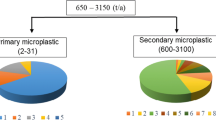Abstract
In the recent study, the bioaccumulation ability of phenolic substances was determined with field-collected specimens of three leech species, i.e., Erpobdella octoculata (Linnaeus), Theromyzon tessulatum (O. F. Műller) and Glossiphonia complanata (Linneaus). It was found that the examined leeches bioaccumulated phenol (0.03–27.10 mg/kg), 4-methylphenol (0.09–1.83 mg/kg), chlorophenols (0.03–14.90 mg/kg), guaiacol (0.22–2,941 mg/kg), tetrachloroguaiacol (0.06–1.98 mg/kg), 3-chlorosyringol (0.04–15.28 mg/kg) and chlorocatechols (0.33–23.24 mg/kg) present in the water (0.03–25.23 μg/L) and in the bottom sediments (0.75–760.5 μg/kg) of three ecosystems that were characterized by different contamination levels. Analysis of both the external mucous coat of the leeches and the tissue of the dermato-muscular sac showed that substantial quantities of the phenolic compounds may be accumulated in both the mucous (0.03–2,941 mg/kg) and the tissue (0.03–1,189.8 mg/kg).

Similar content being viewed by others
References
Bengston A, Henshel D (1996) Environmental toxicology and risk assessment: biomarkers and risk assessment. ASTM International, Atlanta
Brenzen N, Kumke T, Schultz HK, Schultz R (2005) Acroinvertebrate community structure in agricultural streams: impact of runoff-related pesticide contamination. Ecotoxicol Environ Saf 60:37–46
Breton R, Teed S, Morre D (2003) An ecological risk assessment of phenol in the aquatic environment. Human Ecol Risk Assess Int J 9:549–568
Bukowska B (2006) Toxicity of 2,4-dichlorophenoxyacetic acid. Pol J Environ Stud 15:365–374
Caceres T, He W, Naidu R, Megharaj M (2007) Toxicity of chloropyrifos and TCP alone and in combination to Daphnia carinata. The influence of microbial degradation in natural water. Water Res 41:4497–4503
Czaplicka M (2004) Sources and transformations of chlorophenols in the natural environment. Sci Total Environ 332:21–39
Egeler P, Meller M, Roembke J (2001) Tubifex tubifex as a link in food chain transfer of hexachlorobenzene from contaminated sediment to fish. Hydrobiol 463:171–184
Ernst W (1979) Factors effecting the evaluation of chemicals in laboratory experiments using marine organisms. Ecotoxicol Environ Saf 3:90–98
Ernst W, Weber K (1978) Chlorinated phenols in selected estuarine bottom fauna. Chemosphere 11:867–872
Green DWJ, Kendall A, Pascoe W, Pascoe D (1985) Studies on acute toxicity of pollutants to freshwater macroinvertebrates, 2 Phenol. Arch Hydrobiol 103:75–82
Hall K, Jacob C (1988) Bioconcentration of chlorophenols by leeches and their use as in situ biological monitors. Water Pollut Res J Can 23:69–87
Hoekstra E, De Weerd H, De Leer E (1999) Natural formation of chlorinated phenols, dibenzo-p-dioxins and dibenzofurans in soil of a Douglas fir forest. Environ Sci Technol 33:2543–2549
IARC (1995) Monographs on the evaluation of carcinogenic risk to humans. In: Dry cleaning, some chlorinated solvents and other industrial chemicals, Vol. 63. International Agency for Research Cancer, Lyon
Jones PA (1981) Chlorophenols and their impurities in the Canadian environment. Economic and technical review report EPS-3-EC-81-2. Environment Canada. Environmental protection service, Ottawa, pp. 434
Jung J, Ishida K, Nishihara T (2004) Anti-estrogenic activity of fifty chemicals evaluated by in vitro assays. Life Sci 74:3065–3074
Kjallstrand J, Ramnas C, Petersson G (2000) Methoxyphenols from burning of Scandinavian forest plant material. Chemosphere 41:735–741
Kukkonen (2002) Lethal body residue of chlorophenols and mixtures of chlorophenols in benthic organisms. Arch Environ Contam Toxicol 43:214–220
Lent Ch (1974) Neuronal control of mucous secretion by leeches: toward general theory of serotonin. Am Zool 14:931–942
Linowiecka D (2007) The information about environmental state within area of Tomaszów Administrative District in 2007, Provincial inspectorate of environmental protection, ARGI Wrocław
Metcalfe J, Fox M, Carey J (1984) Aquatic leeches (Hirudinea) as bioindicators of organic chemical contaminants in freshwater ecosystems. Chemosphere 13:143–150
Metcalfe J, Fox M, Carey J (1988) Freshwater leeches (Hirudinea) as a screening tool for detecting organic contaminations in the environment. Environ Monit Assess 2:147–169
Metcalfe J, Janice L, Hayton A (1989) Comparison of leeches and mussels as biomonitors for chlorophenol pollution. J Great Lake Res 15:654–668
Michałowicz J, Duda W (2007) Phenols—sources and toxicity. Pol J Environ Stud 16:347–362
Michałowicz J, Majsterek I (2010) Chlorophenols, chlorocatechols and chloroguaiacols induce DNA base oxidation in human peripheral blood lymphocytes (in vitro). Toxicol 268:171–175
Michałowicz J, Ożadowicz R, Duda W (2005) The analysis of chlorophenols, chlorocatechols, chlorinated methoxyphenols and monoterpenes in sewages of group purification plant in Łódź and in the Ner River in years of 1999–2000. Water Air Soil Pollut 164:205–222
Michałowicz J, Bukowska B, Duda W (2008) Phenolic compounds in rivers exposed and non-exposed to anthropogenic pollution. Chemosphere 71:735–741
Michałowicz J, Stufka-Olczyk J, Milczarek A, Michniewicz M (2011) Analysis of annual fluctuations in the content of phenol, chlorophenols and their derivatives in chlorinated drinking water. Environ Sci Pollut Res 18:1174–1183
Moremod C, Roessink I, Jonker M (2007) Impact of polychlorinated biphenyl and polycyclic aromatic hydrocarbon sequestration in sediment on bioaccumulation in aquatic food webs. Environ Toxicol Chem 26:607–615
National Toxicology Program (1989) Toxicology and carcinogenesis studies of two pentachlorophenol technical-grade mixtures (CAS No. 87-86-5) in B6C3F1 mice (feed studies). Technical Report No. 349. NTP, Research Triangle Park
Neumann M, Baumeister J, Liess M, Schulz R (2002) An expert system to estimate the pesticide contamination of small streams using benthic macroinvertebrates as bioindicators II. The knowledge base of LIMPACT. Ecol Indic 2:239–249
Pawłowski L (1936) Leeches (Hirudinea). Polish fresh-water fauna. PWN, Warsaw
Prahacs S, Hall K (1996) Leeches as in situ biomonitors of chlorinated phenolic compounds. Part 1: laboratory investigations. Water Res 10:2293–2300
US EPA (2002) Toxicological review of phenol. U.S. Environmental Protection Agency, Washington, DC
Zhong W, Wong D, Xu X, Luo Q, Wang B, Shan X, Wang Z (2010) Screening level ecological risk assessment for phenols in surface water of the Taihu Lake. Chemosphere 80:998–1005
Author information
Authors and Affiliations
Corresponding author
Rights and permissions
About this article
Cite this article
Grzelak, B., Michałowicz, J. & Dukowska, M. Bioaccumulation of Phenol, Guaiacol and Some Chlorophenols by Selected Freshwater Species of Leeches. Bull Environ Contam Toxicol 88, 976–984 (2012). https://doi.org/10.1007/s00128-012-0597-8
Received:
Accepted:
Published:
Issue Date:
DOI: https://doi.org/10.1007/s00128-012-0597-8




